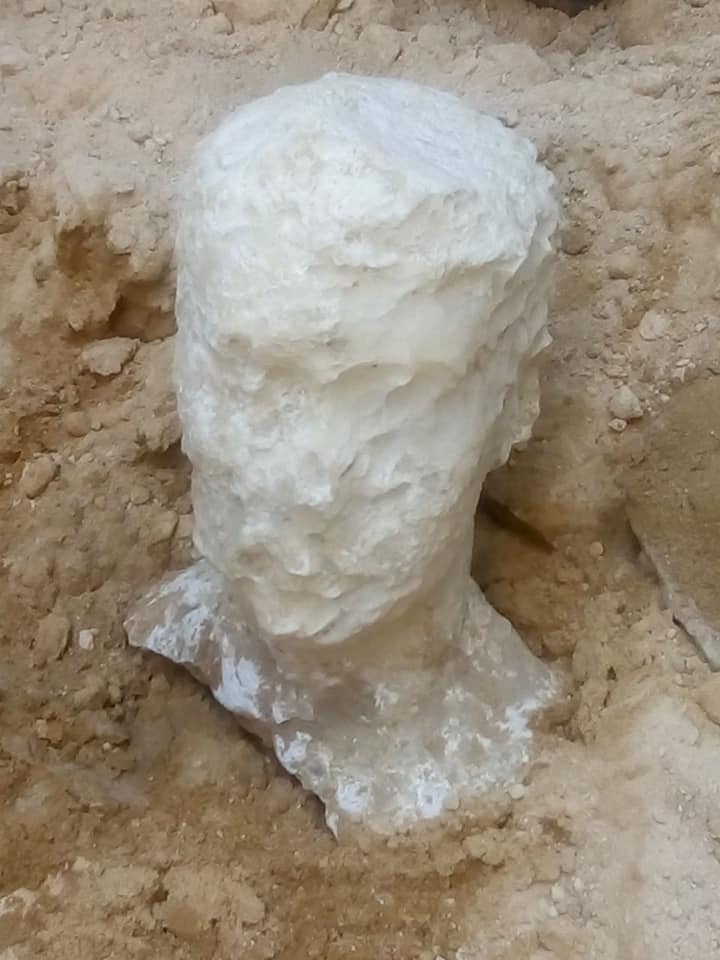Mystery over contents of six foot tall ancient Egyptian sarcophagus discovered in Alexandria
The granite tomb, the biggest ever found in the city, has lain unopened for more than 2,000 years, and some are wondering whether it might even contain the body of Alexander the Great
Made of black granite, the largest ancient Egyptian sarcophagus ever discovered in Alexandria has lain unopened for more than 2,000 years – and no-one knows quite who, or what, lies inside.
The discovery of the black sarcophagus beneath a modern Alexandria street is causing speculation in Egypt and beyond – with some even suggesting it might be the long lost tomb of Alexander the Great.
Speculation has only been intensified by the fact those who discovered the sarcophagus also found the carved alabaster bust of a man’s head that was probably created to represent the tomb’s occupant.

Egypt’s Supreme Council of Antiquities revealed the 185cm (6ft) tall, 265cm long, and 165cm wide sarcophagus was discovered 5m underground by archaeologists inspecting a building site in Alexandria’s Sidi Gaber district.
Dr Ayman Ashmawy, head of the council’s ancient Egyptian antiquities sector, says a layer of mortar between the lid and the rest of the sarcophagus showed the object had not been opened since it was closed, in antiquity.
Officials say the tomb is from the Ptolemaic period, which ended with the death of Cleopatra in 30BC and began in 323BC, when Alexander the Great died and was eventually succeeded as ruler of Egypt by his Macedonian Greek general Ptolemy of Lagus, who became Ptolemy I Soter.
The possible dating of such a large tomb to the period around Alexander’s death has led to social media speculation the sarcophagus might be the final resting place of the general and empire builder.
If that is the case, the contents of the black sarcophagus would solve one of the most enduring mysteries of antiquity.
Despite his huge historical importance, as the founder of one of the largest empires the world has seen – stretching from Greece to modern-day Pakistan – Alexander’s final resting place has never been definitively pinpointed.
The general is known to have died in a palace in Babylon, aged 32, from causes that over the centuries have been ascribed to alcoholic liver disease, typhoid or poisoned wine.
It was recorded that his dying wish was for his corpse to be thrown into the Euphrates river, encouraging his followers’ belief he had gone to the side of Ammon, the god said to have fathered him.
But instead, according to one ancient account, Alexander’s generals spent two years designing and building a funeral cart grand enough to carry their dead leader’s mummified body to a tomb.
They then reportedly began transporting it to what they intended to be Alexander’s final resting place, perhaps near where he was born in Macedonia.
In Syria however, they were intercepted by Ptolemy, who seized the body, probably out of a desire to shore up the legitimacy of his rule in Egypt.
Ptolemy is thought to have taken Alexander’s corpse to Memphis in Egypt.
The body, though, is thought to have been later moved to Alexandria, either by Ptolemy or his son and successor Ptolemy II Philadelphus.
Ancient accounts suggest Alexander was moved yet again by Ptolemy Philopator, who ruled from about 222 to 205BC, and who wanted all his Egyptian ruler predecessors gathered together in one royal mausoleum in Alexandria.
It is said that after Cleopatra died, in 30BC, victorious Roman general Octavian – who later became the Emperor Augustus – visited the mausoleum to place flowers on the tomb and a gold crown upon Alexander’s mummified head.
But in the intervening millennia, the locations of the mausoleum, the first Alexandria tomb and the one at Memphis were all forgotten.
There have been at least 140 attempts to locate Alexander’s final tomb, and none of the claims to have found it has been universally accepted.
If, therefore, the most optimistic speculation turns out correct and the unusually large black granite sarcophagus is proved to be the tomb of Alexander, it would arguably be the archaeological find of the century.
But even if, as is more likely, the tomb has no connection to Alexander, it will still be considered a very significant find as it is relatively rare to find an unopened sarcophagus in Alexandria.
The city’s landowners are required by law to arrange archaeological inspections before carrying out building work and sarcophagi are usually found opened, their contents plundered by looters from ancient or more modern times.
The discovery of the black sarcophagus gives professional archaeologists the chance to use X-rays to look inside without damaging the contents.
These may include not just the body, but also any clothes, jewels or other artefacts the occupant was buried with.
Join our commenting forum
Join thought-provoking conversations, follow other Independent readers and see their replies
Comments